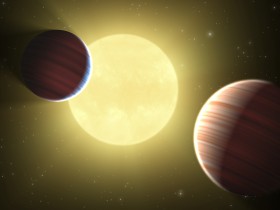
NASA has found a new weird solar system containing stuffy planets closed to eachother in their own orbit to the sun of their own (just like our solar system.
And that’s not all, there are 1200 other clinically possible “explonets” spotted by the orbiting space telescope.
This new discovery is astonishing and mysterious founding for astronomers all over the globe and it let us think how much full of mysteries our universe is. There could be millions of galaxies lurking here and there in our universe that are still undetectable even with modernized equipment that mankind possess as of this date.
The name “Kepler-11” is after the beauty that captured this solar system, and it’s name is Kepler space telescope.
NASA has also written in their report that one of the most amazing feature of Kepler-11 is that they are so closely inclined with each other in their respective orbits.
The star to which all the planets are orbiting around -resembles our very own sun, but the space between 5 of the planets that are orbiting around that star are so closely orbiting that makes that solar system a little different from our solar system.
Plus those planets are more huge and stuffy than our solar system’s lively rocky planets Venus, Earth, Mercury, and Mars, but there are some tiny expolanets as well that NASA had never seen before (i.e. such small size).
Jonathan Fortney of the CA University says that those planets doesn’t necessarily need to resemble our planet Earth, and the low m(–foul word(s) removed–) planets are size of planets like Neptunes unlike Earth which is giant comparatively.
As we earlier said that NASA has found more than 1200 explonets which are mostly giant sack of planets, as they can be seen from such a far distance -hence they must be giant enough to be seen from such far distance.
The telescope Kepler was launched in the month of March year 2009 which is measuring light from one-fifty thousand stars in constellations Lyrae and Cygnus. Their aim is to find such a planet or planets that resembles Earth as much as possible so that scientists could firm if there is any life out there in universe apart from our planet Earth.
NASA further says that though it is not confirm that they really are planets but in near future it should be confirmed that all those elements are planets indeed.
As there is no such telescope that exist so powerful enough that it can directly visualize orbiting of a planet to their star (just like our Solar System), so they follow indirect approaches to discover them.
Kepler-11 System With 6 Planets
[youtube]http://www.youtube.com/watch?v=eC2BqZaHlII[/youtube]
NASA’s Kepler Mission Finds Earth-size Planet Candidates in Habitable Zone
[youtube]http://www.youtube.com/watch?v=WhWReKpM1tg[/youtube]
